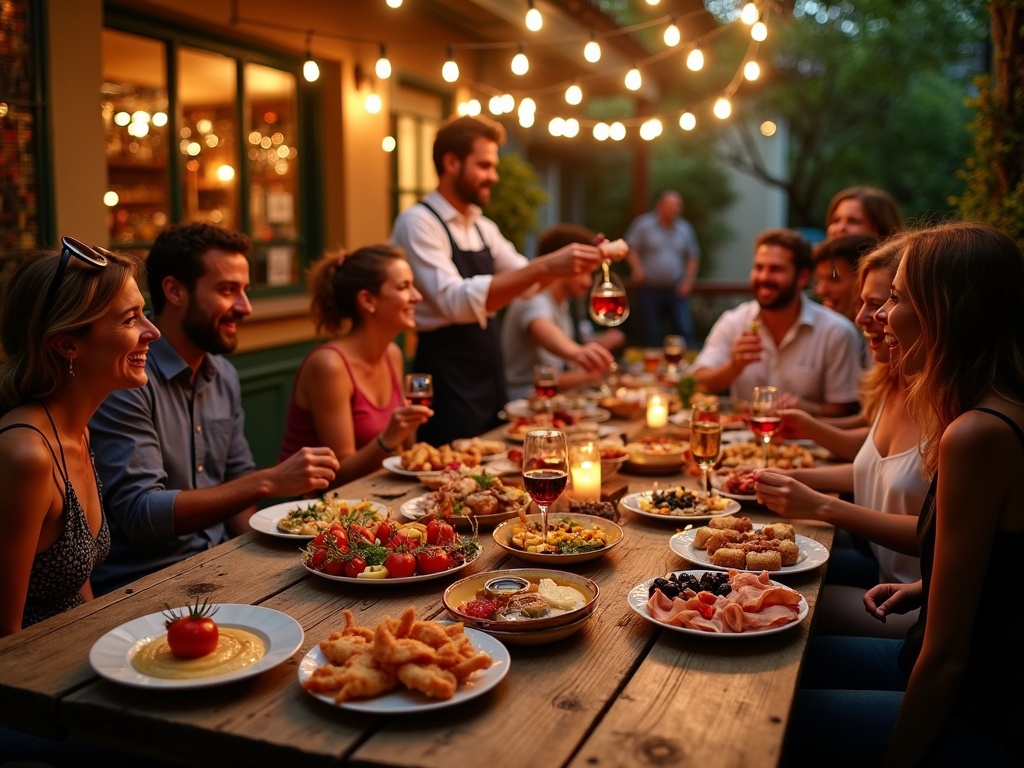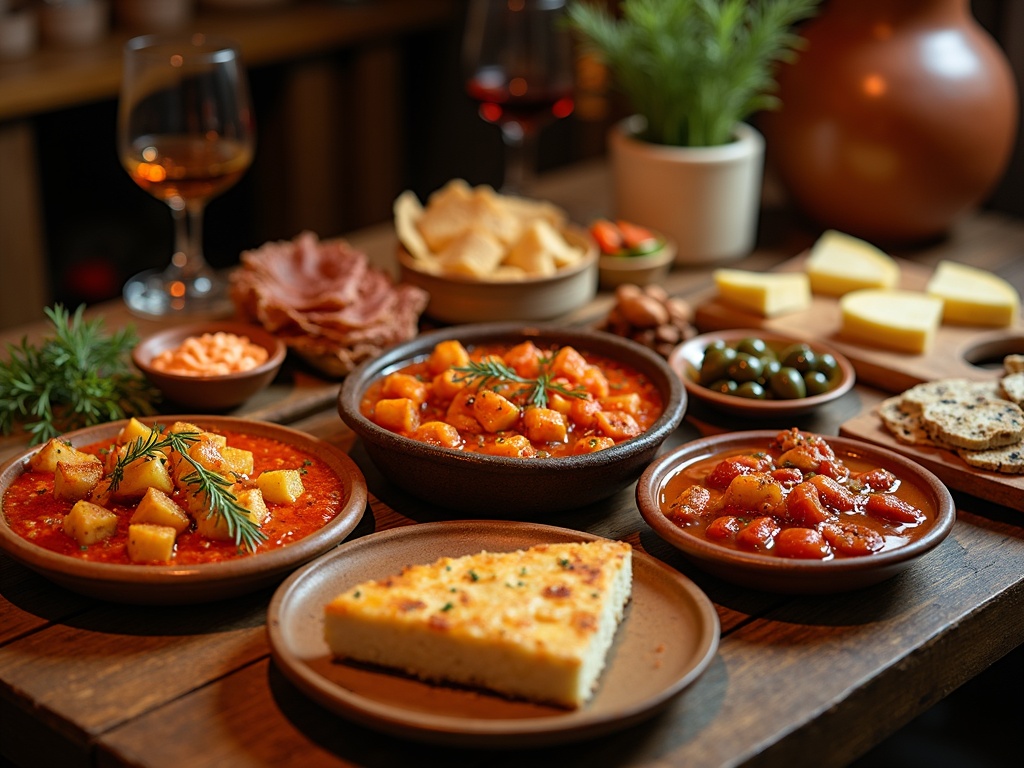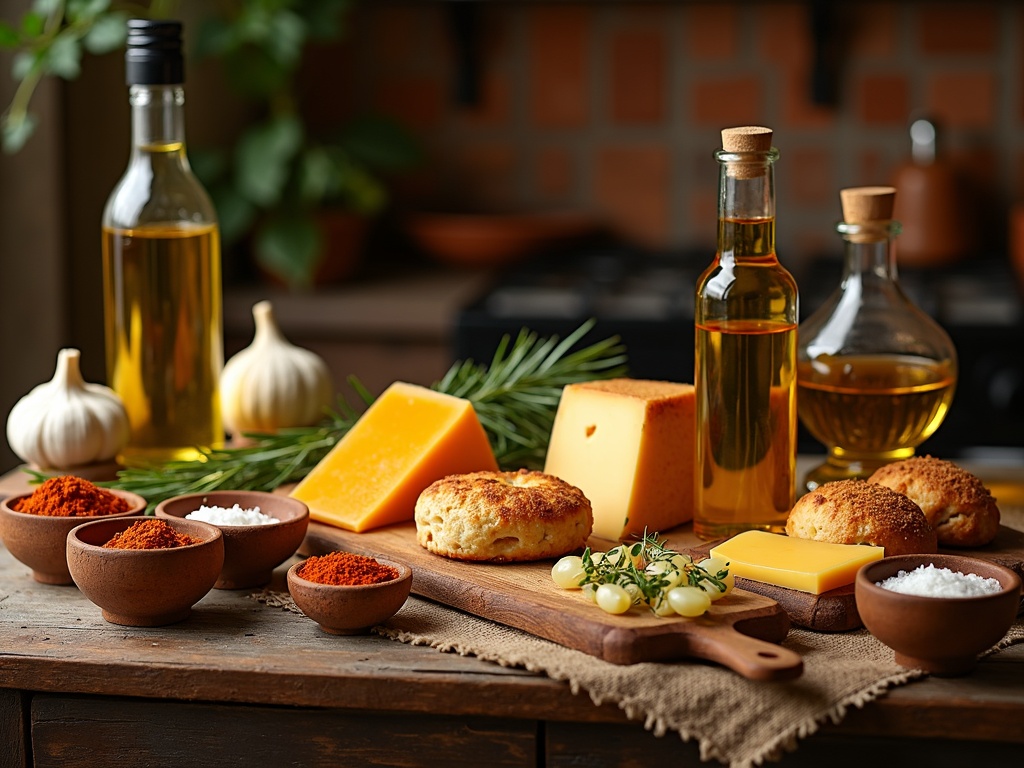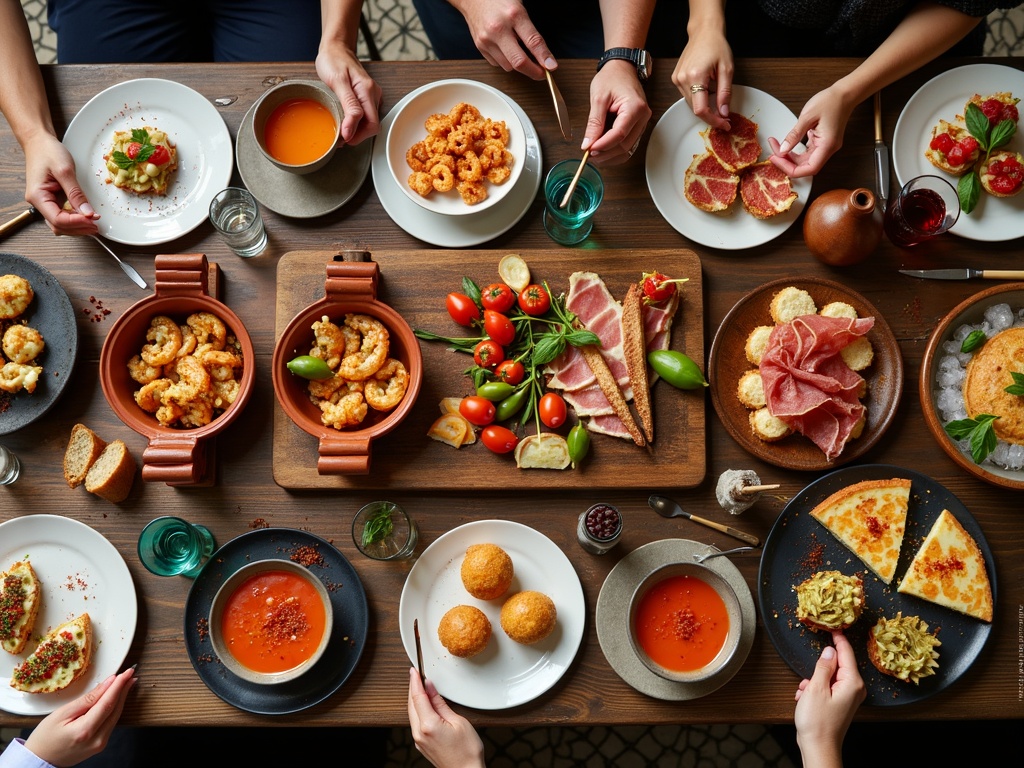Tapas Food represent a quintessential Spanish dining tradition that transcends simple food, embodying a social experience centered on sharing small, flavorful dishes with friends and family. These small plates, which evolved from humble bar snacks to sophisticated culinary creations, showcase Spain’s regional diversity through their incredible variety of hot and cold offerings that encourage communal dining and conversation.
Find In This Article
Key Takeaways
- Tapas culture emphasizes quality ingredients like Spanish olive oil, smoked paprika, and regional cheeses that create distinctive flavors in even the simplest dishes.
- Traditional favorites include patatas bravas, gambas al ajillo (garlic shrimp), Spanish tortilla, and jamón ibérico, which showcase Spain’s culinary heritage.
- The social aspect is fundamental to tapas dining, with dishes typically served in waves rather than all at once, creating a relaxed, conversation-friendly atmosphere.
- Presentation plays a crucial role in authentic tapas service, with specific vessels like cazuelitas (clay dishes) and thoughtful arrangement enhancing the visual experience.
- Proper portion sizing keeps tapas true to their origins—each dish should be just two or three bites, allowing guests to sample many different flavors in one meal.
What Makes Spanish Tapas So Special
Spanish tapas represent far more than just a meal—they’re a cultural institution that embodies Spain’s social spirit and culinary creativity. The tradition of these small, flavorful plates has deep historical roots and continues to enchant food lovers worldwide.
From Humble Bar Snacks to Culinary Sensation
The origin of tapas dates back to the 13th century in Spain, though accounts vary on the exact beginnings. One popular story suggests that King Alfonso X of Castile, while recovering from an illness, could only eat small portions of food with small amounts of wine. After recovering, he decreed that taverns couldn’t serve wine unless accompanied by a small snack or “tapa” (cover).
Another tale claims that bartenders would place a slice of bread or meat atop wine glasses to prevent flies from getting in—literally “covering” the glass, which is where the term “tapa” (cover in Spanish) comes from. Eventually, these covers became increasingly elaborate, evolving into the diverse array of small dishes we know today.
What started as simple bread, cheese, or olives has transformed into an entire category of cuisine featuring complex flavors and techniques. Early tapas were practical—salty foods like cured ham and cheese that would make patrons thirsty and buy more drinks. Over centuries, these humble beginnings developed into sophisticated culinary expressions found across Spain.
I’ve found the social aspect of tapas truly sets them apart from other dining styles. Unlike the structured three-course meals common in many cultures, tapas reflect Spain’s community-centered approach to eating. The practice encourages sharing, conversation, and lingering over food—often called “sobremesa” in Spanish, referring to time spent at the table after eating.
This social dimension makes tapas more than just food; they’re a lifestyle centered around connection. When you order several small plates like bruschetta or other tapas favorites, you’re participating in a centuries-old tradition designed to bring people together.
Regional Tapas Delights
Each region of Spain contributes its own distinctive tapas to the national repertoire:
- Andalusia: Known for gazpacho (cold soup) and pescaíto frito (fried fish)
- Catalonia: Famous for fresh tomato-based dishes like pan con tomate
- Basque Country: Celebrated for pintxos, often served on bread with a toothpick
- Galicia: Renowned for seafood tapas like pulpo a la gallega (octopus)
The beauty of tapas lies in their versatility. They can be hot or cold, traditional or innovative. From simple garlic and yogurt dips to complex stuffed rice balls similar to arancini, the variety is endless.
Global Influence, Local Roots
Today, tapas have transcended their Spanish origins to influence global dining trends. The small-plate concept has been adopted by restaurants worldwide, though authentic Spanish tapas maintain distinctive characteristics tied to their cultural roots.
The communal nature of tapas dining—ordering multiple dishes to share among friends—creates a relaxed, convivial atmosphere that stands in contrast to formal dining traditions. This approach encourages exploration and discovery, letting diners sample many flavors in one meal rather than committing to a single dish.
Modern Spanish chefs continue to innovate within the tapas tradition, incorporating global influences while honoring traditional techniques. Even vegetarian options like spinach-filled pastries and cold vegetable soups have become popular tapas offerings.
What makes tapas truly special isn’t just their taste but their ability to transform a meal into an event—an opportunity to connect, converse, and celebrate the simple pleasure of good food shared with others. This cultural approach to eating explains why tapas have captured imaginations worldwide and continue to be one of Spain’s most beloved culinary exports.

Must-Try Traditional Tapas Dishes
Spanish small plates have captured the hearts and palates of food enthusiasts worldwide. These sharable bites showcase Spain’s culinary diversity through simple yet flavorful combinations. Let me walk you through some essential traditional tapas that deserve a spot on your table.
Hot Tapas Classics
Patatas bravas stands as perhaps the most iconic tapa, featuring crispy fried potato cubes smothered in a spicy tomato sauce. The contrast between the creamy interior of the potatoes and the tangy, slightly spicy sauce creates an irresistible combination. It’s the perfect entry point for those new to tapas culture.
Gambas al ajillo delivers an aromatic punch with its simple preparation of fresh shrimp sautéed in olive oil infused with garlic and chili flakes. The sizzling arrival of this dish at Spanish bars signals a treat for both the eyes and taste buds. I always recommend soaking up the flavorful oil with crusty bread.
The humble Spanish tortilla offers comfort in every bite. Unlike its Mexican namesake, this thick potato and onion omelet showcases how elevated simple ingredients can become. Served warm or at room temperature, it’s versatile enough for any tapas spread and pairs beautifully with a glass of crisp Spanish gazpacho on the side.
Chorizo in wine sauce brings smoky, savory elements to the table. The paprika-spiced sausage releases its oils when cooked in red wine, creating a rich sauce that’s perfect for dipping bread into. The simplicity of this preparation highlights why Spanish cooking focuses on quality ingredients rather than complex techniques.
Cold Tapas Essentials
No tapas experience is complete without jamón ibérico, Spain’s prized cured ham. Thinly sliced and served simply with bread, this delicacy represents generations of traditional preservation methods. The complex flavor profile develops as the ham ages, creating nutty, savory notes that pair perfectly with crusty bread slices similar to those used in bruschetta.
For a brighter option, consider these additional cold tapas favorites:
- Marinated olives with citrus and herbs
- Manchego cheese with quince paste
- Boquerones (white anchovies in vinegar)
- Fresh tomato-based dips with crusty bread
The beauty of tapas culture lies in its accessibility—you can create an impressive spread with just a few key dishes. I particularly enjoy combining both hot options like crispy fried dishes with cold selections for textural contrast. Even yogurt-based dips can complement the rich flavors of traditional Spanish tapas.
When serving these dishes at home, embrace the casual, unhurried approach that defines authentic Mediterranean entertaining. The focus should remain on conversation and connection, with food serving as the delicious catalyst for gathering.

Essential Ingredients for Making Tapas
The foundation of authentic tapas relies on a handful of key ingredients that bring those distinctive Spanish flavors to life. When I’m preparing these small but mighty dishes at home, I focus on quality components that can transform simple preparations into memorable bites.
Core Spanish Pantry Staples
Spanish olive oil sits at the foundation of nearly all tapas creations. Unlike lighter varieties, Spanish olive oil offers a rich, fruity profile that adds depth to everything from simple bread-based tapas to complex seafood dishes. I prefer extra virgin varieties from regions like Andalusia or Catalonia for their pronounced character.
Fresh garlic is another non-negotiable ingredient. Spanish cooking uses garlic generously, often raw in cold dishes like traditional gazpacho soups or gently sautéed as a base for hot tapas. The pungent aroma creates that unmistakable Spanish kitchen scent that signals good things are coming.
Smoked paprika (pimentón) transforms ordinary dishes with its distinctive smoky flavor. Available in sweet (dulce), bittersweet (agridulce) and spicy (picante) varieties, this brick-red spice adds color and depth to classics like patatas bravas or crispy rice balls with a Spanish twist.
Sea salt, particularly flaky varieties from coastal regions, brightens all the other flavors. I use it both during cooking and as a finishing touch on many tapas dishes. A final sprinkle can elevate something as simple as pan con tomate to new heights.
Fresh Elements That Make Tapas Shine
Fresh herbs provide the aromatic lift that makes Spanish food sing. Parsley is most common, appearing in everything from fresh tomato-based salsas to seafood preparations. Other important herbs include thyme, rosemary, and bay leaves, especially in slow-cooked tapas options.
Regional Spanish cheeses offer countless opportunities for simple yet spectacular tapas. These distinctive options create instant character on any spread:
- Manchego: Spain’s most famous sheep’s milk cheese, ranging from young and mild to aged and complex
- Idiazábal: A lightly smoked sheep’s cheese with nutty notes
- Tetilla: A creamy cow’s milk cheese with a distinctive nipple shape
- Cabrales: A bold blue cheese perfect for those who appreciate stronger flavors
- Mahón: A cow’s milk cheese with a fruity, salty profile that pairs beautifully with membrillo (quince paste)
For a complete tapas experience, consider adding Mediterranean pastries or cool yogurt-based dips alongside these Spanish specialties for textural contrast. The beauty of tapas lies in mixing and matching flavors for an exciting dining experience.

How to Serve Tapas Like a Pro
Serving tapas isn’t just about the food—it’s about creating an experience. I’ve found that mastering a few key elements can transform ordinary small plates into an authentic Spanish feast that wows guests every time.
Presentation and Serving Techniques
Small portions deserve special attention to presentation. I always arrange tapas with height and color variation to create visual interest on each plate. A simple drizzle of olive oil or a sprinkle of paprika can elevate even the most basic dish.
Traditional serving vessels play a crucial role in authentic tapas presentation:
- Cazuelitas (small clay dishes) are perfect for hot items like garlic shrimp
- Wooden boards work wonderfully for sliced meats and cheeses
- Small white ceramic plates provide an elegant backdrop for colorful dishes like vibrant tomato bruschetta
- Slate tiles offer dramatic contrast for lighter-colored foods
Temperature control can make or break your tapas service. Hot dishes should arrive steaming at the table, while cold options need to maintain their chill. I always keep hot dishes like crispy arancini balls under warming lamps or in hot water baths until the last possible moment before serving.
Cold tapas like refreshing gazpacho shots should be refrigerated until just before presentation. For items like Spanish tortilla, room temperature is actually ideal for full flavor development.
Creating the Perfect Tapas Flow
The art of tapas lies in thoughtful combinations and timing. I’ve learned that complementary flavors create the most memorable experiences. Balance is key—pair rich, fatty items like chorizo with acidic counterpoints such as fresh pico de gallo or marinated olives.
These pairings work exceptionally well:
- Garlic shrimp alongside crusty bread for soaking up the flavorful oil
- Manchego cheese with quince paste for a sweet-savory contrast
- Flaky spanakopita with cool tzatziki dip for temperature variation
- Patatas bravas paired with aioli for richness and albondigas (meatballs) for substance
- Marinated artichokes with jamón serrano for complementary textures
Timing between servings creates the relaxed, social atmosphere that tapas dining is famous for. Instead of presenting everything at once, I space dishes 10–15 minutes apart, starting with lighter cold items before moving to richer hot plates. This pacing encourages conversation and prevents overwhelming your guests.
For authentic service, I’ve found that bringing just 2–3 tapas at a time works perfectly. This approach mirrors how you’d experience tapas in Spain—as a gradual parade of small bites that allows guests to savor each offering.
When hosting larger groups, I create stations around my entertaining space rather than crowding one table. This encourages movement and mingling, capturing the lively spirit of Spanish tapas culture. Small plate stands and tiered servers maximize limited space while creating an appealing display.
The beauty of tapas service is its flexibility—you can adjust presentations based on formality. For casual gatherings, family-style sharing plates work beautifully, while individual portions on small plates create an elevated experience for more formal occasions.
By focusing on these serving techniques, you’ll create an authentic tapas experience that delights guests and showcases these beloved Spanish small plates at their very best.

Creating the Perfect Tapas Food Party
Tapas culture is all about sharing, socializing, and savoring small bites of delicious food. I’ve hosted dozens of tapas gatherings, and the key to success lies in thoughtful planning and strategic execution. Let’s dive into how you can create a memorable tapas experience for your guests.
Smart Planning for a Seamless Experience
When planning portions, I aim for 5–7 small plates per person. This might sound like a lot, but remember that tapas are meant to be bite-sized. For a party of six, I typically prepare 8–10 different dishes in quantities that allow everyone to have a taste. Popular options include classic bruschetta topped with tomatoes and basil, or the crispy perfection of homemade arancini balls.
Balancing hot and cold dishes creates a dynamic spread and makes your job as host much easier. I’ve found that a 60/40 split between cold and hot items works perfectly. Cold options like traditional gazpacho or fresh pico de gallo can be prepared hours ahead, while hot items like crispy spanakopita can go into the oven as guests arrive.
Setting up designated serving stations prevents crowding and creates natural gathering spots throughout your space. I like to create three distinct areas:
- A cold station with dips, cheeses, and no-heat required items
- A hot station near the kitchen for items straight from the oven
- A drinks station with wine, sangria, and non-alcoholic options
Speaking of drinks, Spanish wines naturally complement tapas. Albariño or Verdejo pairs beautifully with seafood tapas, while a medium-bodied Tempranillo works magic with meatier options. For a complete experience, offer a simple sangria and a non-alcoholic option like sparkling water with citrus.
Timing your preparation is crucial for enjoying your own party. My timeline typically looks like this:
- 2 days before: Shopping and menu finalization
- 1 day before: Prepare all cold items, dips like tangy tzatziki, and marinated ingredients
- 3 hours before: Set up serving stations and prepare drinks
- 1 hour before: Begin preparing hot items that can be held warm
- As guests arrive: Pop the final hot items into the oven
With careful planning and these strategies, your tapas party will hit all the right notes—varied flavors, relaxed pacing, and plenty of time for you to enjoy the company of your guests rather than being stuck in the kitchen.

Common Tapas Food Making Mistakes
Tapas are meant to be small, flavorful bites that showcase Spanish cuisine’s best qualities. Despite their seemingly simple nature, creating the perfect tapas spread involves attention to detail and avoiding some common pitfalls. I’ve identified several mistakes that can detract from an authentic tapas experience.
Preparation Errors
Overcrowding plates is a mistake I see frequently, even in tapas restaurants. When too many items compete for space, the visual appeal diminishes and flavors can blend unintentionally. Instead, I recommend arranging 3–4 items per small plate, giving each component room to shine. This approach also makes it easier for guests to identify and appreciate each distinct offering.
Using the wrong olive oil can significantly impact your tapas. Spanish cuisine relies heavily on high-quality olive oil, particularly extra virgin varieties. For cold dishes like traditional Spanish gazpacho or simple bruschetta with fresh tomatoes, I always use the best extra virgin olive oil I can find. For cooking, a less expensive but still good quality olive oil works perfectly for dishes like crispy arancini balls.
Improper temperature control can ruin otherwise perfect tapas. Hot dishes like patatas bravas should be served immediately after cooking to maintain their crispy texture. Cold items such as tangy tzatziki need proper chilling. I’ve learned to stagger my cooking schedule to ensure each dish arrives at the table at its ideal temperature.
Service and Presentation Mistakes
Serving everything at once is a common error that undermines the tapas dining philosophy. Traditional Spanish tapas culture centers around a leisurely experience with dishes arriving in waves. I prefer serving 2–3 dishes at a time, creating natural breaks in the meal that encourage conversation and prevent palate fatigue.
Neglecting presentation can diminish the impact of even the most delicious tapas. Spanish cuisine emphasizes vibrant colors and artistic arrangements. Simple touches make a difference:
- Using colorful ceramic dishes rather than plain white plates
- Adding fresh herbs as garnish
- Arranging items with height variation
- Including bright pico de gallo or flaky spanakopita for color contrast
I’ve found that taking just an extra minute to consider the visual appeal of each plate elevates the entire tapas experience. After all, these small bites should entice visually before the first taste.
Tips for Authentic Tapas Experience
Creating genuine Spanish tapas at home isn’t difficult once you understand the core principles. I’ve found that authentic tapas experiences hinge on several key elements that transform simple dishes into memorable feasts.
Essentials for Perfect Tapas
Quality ingredients make all the difference when preparing tapas. I recommend using genuine Spanish products whenever possible – think Manchego cheese, Spanish olive oil, pimentón (smoked paprika), and Serrano ham. These foundational ingredients carry distinctive flavors that can’t be replicated with substitutes.
Most tapas are best served at room temperature, which allows their flavors to fully develop. I set dishes out about 30 minutes before serving. This practice applies perfectly to classics like tomato-topped bruschetta or refreshing gazpacho in summer months.
Portion size matters tremendously in tapas culture. Keep your servings small – just two or three bites per dish. This approach allows guests to sample more varieties without feeling overwhelmed. Small portions of crispy arancini or fresh pico de gallo exemplify this approach perfectly.
The social aspect of tapas can’t be overstated. I always arrange my table to encourage sharing and conversation. Place dishes in the center where everyone can reach them, and provide small plates for each guest. This communal dining style creates the relaxed, convivial atmosphere that defines Spanish eating.
Pacing your service brings the experience together. Rather than serving everything at once, I bring out dishes gradually in waves of two or three. This approach:
- Keeps food at optimal temperatures
- Creates natural conversation breaks
- Allows appreciation of each dish’s unique flavors
- Prevents table overcrowding
- Extends the enjoyment of the meal
For a complete Mediterranean experience, consider adding flaky spanakopita or cooling tzatziki to your spread, creating a tapestry of flavors from across the region.
Remember that authentic tapas are meant to be casual and fun. Focus on creating a relaxed atmosphere where food and conversation flow freely, and you’ll capture the true spirit of Spanish dining.

